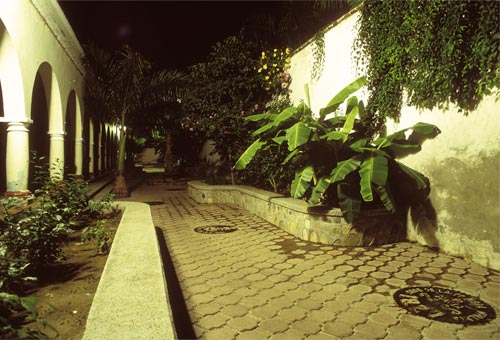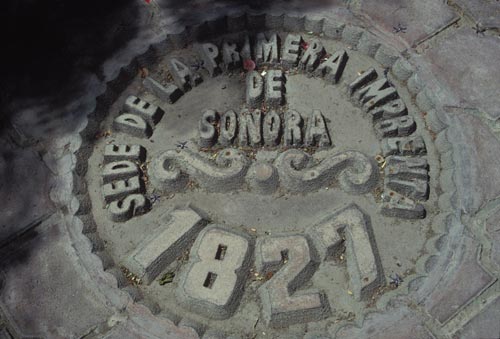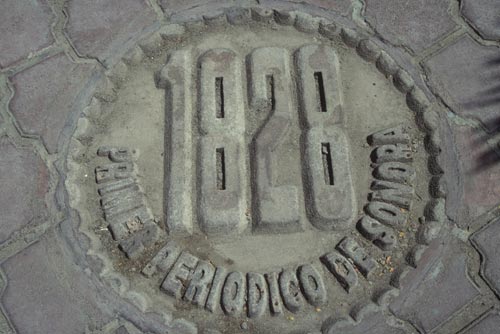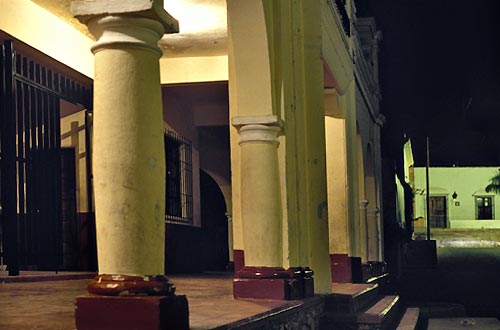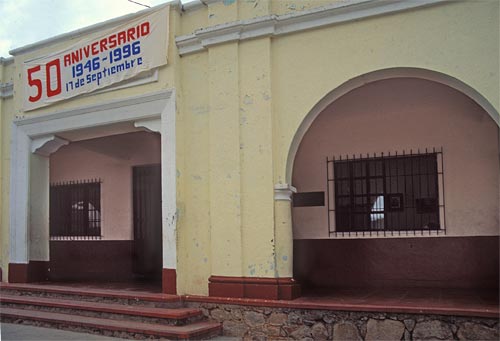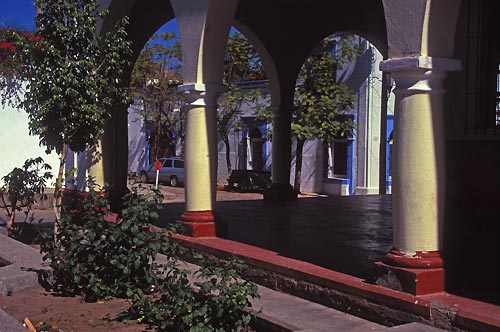36- A walk through modern history at Escuela Paulito Verjan …
TThe streets are empty. I will not see another person on this walk from
Calle Comercio to Escuela Paulito Verjan, a middle school and back,
but, I am not alone. I am with everyone that have traveled these
pathways throughout the years at night. My shoes land in their footprints.
There is rustling in flowering vines still wet from a summer rain.

Shadows are small as the sun nears its zenith. Medallions speak of other zeniths.
How many times as this man took this path to Álamos Centro? How many times has
he stopped to read a history medallion? How many times has he appreciated where
he is? How many times has he felt grateful this is where his family is? Some of
his grand children, at this moment, may be behind the school’s portales studying.
1684, sixteen-eighty-four, and Álamos is part of the new frontier. Thinking back
makes me wonder about the future. 2084, twenty- eighty-four, and what will one
see standing in this very spot? And, 2184, twentyone-eighty-four? and… Whoa!
Time to take a couple of deep breathes and enjoy being in the present.

A new catheral rises from the grounds of the town’s first small adobe church.
Construction began in 1786 on Bishop Reyes Cathedral also known as now
known as Parroquiade La Purísima Concepción. Official records indicate
that work on the church began in 1786. Álamos elected three town folk
to supervise work and manage the budget. The church was finished in 1803.
Ladies from the wealthy homes of Álamos were asked to contribute one
of their fine china to decorate the nearly completed cathedral
History is the record of events occurring and needs being fulfilled.
It is easy to ask what came first. The answer, or better yet answers,
are part of a grand multiple causation continuum and are not that
easy to formulate. But we try, that is part of being human.
This is another milestone in the development of Sonora and all
of western settlement. Here, it is easy to answer what came first.
First, there was a printing press and then there was a newspaper.
A short walk from Escuela Paulito Verjan are operational 100 year
old presses in a family run printing shop. It is the human way.
Álamos, Sonora, México has a long and literate history.

Álamos had become an important capital city on the frontier.
Here, at the foot of the Sierra de Álamos and at the end of
Calle Comercio decisions were being made that impacted many people
in the newly combined Sinoloa and Sonora – the state of Occidente.
Construction began in 1928 on Governor Jose Maria Gaxiola’s
new home and official residence on Calle Comerico.

The mint is opened for big business.
Making money with the silver coming from Aduana, seven miles to the
west, added to Álamos power and prestige. The first mint in Alamos was
established by D. Leonardo Santoyo, with a concession or grant, obtained
from the federal government,permitting him to coin only copper coins.
Coinage was produced only in 1828 and 1829 since the copper coins were
not accepted by the people.

Ramón Corral, publisher, writer, and government official.
Ramón Corral was born outside of Álamos January 10, 1854 on
Hacienda Las Mercedes where his father worked. He first gained
attention in 1872. For political reasons he founded the
newspapers El Fantasma (The phantom) and La Voz de Álamos
(The voice of Álamos). In 1887 Corral was the General Secretary
of the Government of Sonora and interviewed the captured
Yaqui military leader Cajemé. Corral published biographical
notes about Cajemé In La Constitución (Periódico oficial del
gobierno del estado libre y soberano de Sonora),

A deadly day on Guadalupe Hill between the Plaza and Alameda.
September 22 – General Antonio Rosales, with less than 500 troops,
leaves El Fuerte to recapture Álamos from the French Imperialists.
Rosales forces met Colonel Almada’s larger force in a three hour
battle on Guadalupe Hill. Rosales and many of his men, possibly a
third, were killed. Rosales was buried in the Álamos cemetery.
His body was later moved to Mexico City.

1866 – Sonora is restored to the Republic.
On January 7, 1886 General Angel Martinez successfully attacked
Colonel Jose Maria Tranquilino Almada’s led Imperialists on
the edge of Álamos into the Plaza. Álamos was plundered and the
Church’s meltable precious metals were stripped away. Almada attacked
Minas Nueva in on the last day of May and for a couple of weeks
regained Alamos. He was forced to give up the city on August 28.
The French garrison in Guaymas was abandoned after several defeats
in central Sonora. Sonora rejoined the Republic in September, 1886.

Álvaro Obregón Salido: General, elected President of México twice.
Obregón, born February 19, 1880, was a general in the Méxican Revolution
and was elected President in 1920 to 1924. He presidency was relatively
stable marked with eductaion reform and labor laws benefiting workers.
He was elected President again in 1928 but was assassinated
before he could start his term.

1889 – Another great person is born in Álamos.
Professor Othón Almada is one of many people born in Álamos who rose to
either regional, national or international recognition and influence.
Othón Alamada became Secretary of Public Education in the State of
Sonora. Many schools in Sonora are named after him. Today in the
Álamos school system there are many who may take leadership roles
in the future of Sonora, México or possibly the world.

Alfonzo Ortiz Tirado: doctor, opera singer, philanthropist.
Alfonso Ortiz Tirado was an opera singer and medical doctor born in
Álamos, Sonora, January 24, 1893 . His musical talent was apparent early
in life, but he studied at the Escuela Nacional Preparatoria and
university to become a doctor. He specialized in gynecology as well
as general medicine, and eventually became the personal physician of
Frida Kahlo and performed surgery on Agustín Lara. As a musician,
he studied under José Pierson and soon afterward had a successful
international career as an opera singer, earning the label of
“tenor of the Americas.” He earned a large sum of money doing this,
and used it to establish a children’s hospital in Mexico City.
The Festival de Canto Operístico Tirado in the state of Sonora
was named after him.
Not faraway colorful parrots sleep high in Sierra de Álamos’ rocky canyons and
scattered forests. A dog barks at the same instant a radio is turned off.
Everyday, history is in the making, it never stops. Escuela Paulito Verjan’s
70th anniversary is just around the corner and then it too will be history.
Think of what Álamos will be like in 2046?
Secondary School morning recess on a late 1997 Spring day…
What better place to start than with the children of Álamos. Escuela Paulita Verjan,
grades 7 through 10, sits on the site that was the Alamos mint from 1864 -1869.
This photo opportunity was assisted by the young man waving at the camera in the
foreground. His english was flawless. He would impress anyone who saw him interacting
with peers and adults around town, working the front desk at the Hotel Los Portales
and speaking with passion in front of a huge crowd on Independence Day in the Plaza.
An introduction to a Short History of Álamos, Sonora, Mexico.
“Here is something Special”, Spanish explorer Vasquez de Coronado noted in 1540
as he headed north, passing by tall white rocks on Alamos de Sierra. This is the
opening chapter to “A Short History of Álamos” written, filmed and edited by
Anders Tomlinson. Narrated by Bruce Miles. Soundtrack by SonicAtomics
and Estudiantina de Álamos.
![]()
Álamos shares a strong maternal bond, steeped in history, with all the
Southwest. Juan Batista de Anza arrived and departed from Álamos in the
spring of 1775 with silver, and local families, to settle “Monterey and the Californias”,
including San francisco. Another expedition, five years later,
left Álamos to settle Los Angeles.
![]()
The conclusion to a Short History of Álamos, Sonora, Mexico.
Here, Bishop Reyes’ Cathedral in the Plaza, a three-tiered belfry, shines gold
in morning light. Here, looking east, one’s imagination is stirred by the
forbidding beauty of the Sierra Madre Occidentals. Together, they shape
the Álamos experience.
![]()
To see more Álamos Journal pages.
To return Home.
©2013 Anders Tomlinson, all rights reserved.
